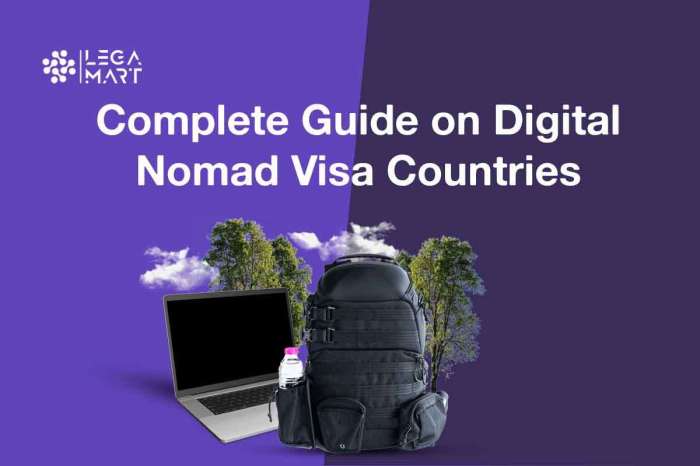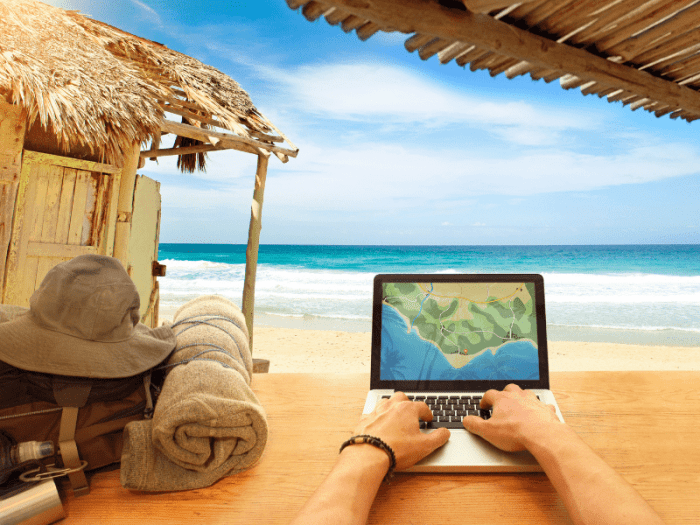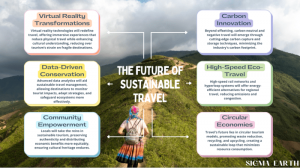
Digital nomad visa programs are rapidly transforming how individuals work and travel. These programs offer a unique opportunity to live and work remotely in various countries, blending professional life with exploration and cultural immersion. However, understanding the nuances of each program, from eligibility requirements to visa durations and costs, is crucial for a seamless transition. This guide provides a comprehensive overview, helping aspiring digital nomads navigate the complexities and make informed decisions.
We will explore the benefits and drawbacks for both individuals and host countries, comparing different visa types and highlighting popular destinations. The application process, potential challenges, and the impact on local economies will also be examined. Finally, practical advice on travel planning, budgeting, and maintaining a work-life balance will ensure a fulfilling digital nomad experience.
Overview of Digital Nomad Visa Programs
Digital nomad visas represent a relatively recent phenomenon, reflecting a global shift towards remote work and increased international mobility. These visas are designed to attract skilled professionals who can work remotely while contributing to the host country’s economy, typically through spending and supporting local businesses. They offer a legal framework for individuals to reside in a country for a specified period, allowing them to conduct their work without facing immigration hurdles.Digital nomad visa programs offer several key advantages for both individuals and countries.
For individuals, these visas provide the opportunity to live and work in a new environment, experience different cultures, and potentially lower their cost of living. For countries, they attract high-skilled workers who contribute to the economy through spending and taxation, boosting local businesses and potentially filling labor shortages in specific sectors. However, there are also drawbacks. Individuals may face challenges adapting to a new culture, navigating local laws, and ensuring access to adequate healthcare.
Countries might face concerns about potential strain on infrastructure or the creation of a two-tiered system if access to these programs is limited.
Types of Digital Nomad Visas, Digital nomad visa programs
Digital nomad visas vary significantly across countries, with differences in duration, requirements, and eligibility criteria. Some programs offer short-term stays, while others allow for longer-term residency. Requirements typically involve proof of sufficient income, health insurance, and a clean criminal record. Eligibility often depends on factors such as nationality and the nature of the applicant’s remote work. Below is a comparison of several examples, though it’s crucial to check the most up-to-date information from official government sources as requirements can change frequently.
| Country | Visa Duration | Requirements | Cost |
|---|---|---|---|
| Portugal (D7 Visa – While not strictly a digital nomad visa, it’s often used as such) | Initially 1 year, renewable | Proof of passive income, clean criminal record, health insurance | Varies depending on processing fees |
| Thailand | Multiple options, including a Smart Visa with a potential 4-year duration | Proof of income, health insurance, and sometimes a business plan | Varies based on the type of visa and processing |
| Mexico (Temporary Resident Visa – often used by digital nomads) | Up to 4 years, renewable | Proof of sufficient funds, health insurance, and possibly a business plan | Variable costs associated with application and processing |
| Iceland | Up to 6 months (potentially extendable) | Proof of sufficient income, health insurance, and a valid passport | Application fees apply |
| Germany (Freelancer Visa) | Initially 1 year, renewable | Business plan, proof of sufficient funds, health insurance | Variable costs |
Popular Digital Nomad Visa Destinations
The allure of working remotely from exotic locations has fueled the rise of digital nomad visa programs globally. These programs offer individuals the opportunity to live and work in a foreign country for an extended period, often with streamlined visa processes compared to traditional work visas. This section highlights some of the most popular destinations and details the specifics of their programs.
Numerous countries have recognized the economic benefits of attracting digital nomads and have developed tailored visa programs to accommodate this growing demographic. These programs vary in their requirements, durations, and associated costs, making it crucial for prospective digital nomads to carefully research their options before applying.
Digital Nomad Visa Programs: A Selection of Popular Destinations
Below is a list of ten countries offering popular digital nomad visa programs. Each offers a unique blend of lifestyle, cost of living, and visa requirements.
- Portugal (D7 Visa and Digital Nomad Visa): Offers a relatively straightforward application process and a lower cost of living compared to some other European countries.
- Spain (Digital Nomad Visa): A popular choice due to its culture, climate, and relatively easy application process.
- Greece (Digital Nomad Visa): Combines beautiful scenery with a welcoming atmosphere for remote workers.
- Iceland (Digital Nomad Visa): Appeals to those seeking a unique and adventurous experience in a stunning natural environment.
- Germany (Freelancer Visa): While not strictly a “digital nomad visa,” Germany’s freelancer visa caters to remote workers.
- Mexico (Temporary Resident Visa): Offers a relatively affordable cost of living and a rich cultural experience.
- Thailand (Smart Visa): Designed to attract high-skilled professionals, including digital nomads.
- Indonesia (B211A Visa): A relatively inexpensive option with diverse island cultures and a tropical climate.
- Costa Rica (Digital Nomad Visa): Boasts stunning natural beauty and a relaxed lifestyle.
- Malta (Nomad Residence Permit): Offers a stable political and economic environment within the European Union.
Detailed Requirements and Application Processes: Portugal, Spain, and Thailand
Three of the most sought-after digital nomad visa programs are those offered by Portugal, Spain, and Thailand. The following details Artikel the specific requirements and application processes for each.
- Portugal (Digital Nomad Visa): Generally requires proof of sufficient income (typically demonstrating a monthly income above a certain threshold), proof of health insurance, and a clean criminal record. The application process involves submitting the necessary documentation to the Portuguese consulate or embassy in the applicant’s home country.
- Spain (Digital Nomad Visa): Similar to Portugal, Spain’s digital nomad visa requires proof of sufficient income, health insurance, and a clean criminal record. Applicants must demonstrate that they can work remotely and will not be employed by a Spanish company. The application process involves submitting the documentation to the Spanish consulate or embassy.
- Thailand (Smart Visa): This visa is more complex and targets high-skilled professionals. Requirements include a minimum income threshold, a business plan demonstrating a contribution to the Thai economy, and often requires sponsorship from a Thai entity. The application process is more rigorous and may involve multiple stages of review.
Cost of Living, Infrastructure, and Cultural Aspects: A Comparison
Comparing the cost of living, infrastructure, and cultural aspects of three popular digital nomad destinations – Portugal, Thailand, and Mexico – provides valuable insight for potential applicants.
| Feature | Portugal | Thailand | Mexico |
|---|---|---|---|
| Cost of Living | Moderate; higher than Thailand, lower than many other Western European countries. | Low; particularly affordable outside major cities. | Low to moderate; varies significantly by location. |
| Infrastructure | Generally excellent; reliable internet access in most urban areas. | Good in major cities; can be less reliable in rural areas. | Variable; good infrastructure in major cities, but can be lacking in smaller towns. |
| Cultural Aspects | Rich history and culture; relatively easy to integrate for English speakers. | Unique and vibrant culture; requires some effort to adapt to local customs. | Rich and diverse culture; Spanish language skills are highly recommended. |
Requirements and Application Process for Digital Nomad Visas
Securing a digital nomad visa involves navigating a specific set of requirements and a potentially complex application process. The specifics vary significantly depending on the country, but understanding the general framework is crucial for a successful application. This section Artikels typical documentation, steps involved, potential challenges, and a step-by-step guide to aid in the process.
Typical Documentation Needed for Digital Nomad Visa Applications
Applicants should anticipate needing a comprehensive package of documents to support their application. The exact requirements are country-specific, but common elements include proof of identity, financial means, health insurance, and evidence of remote work. Failing to provide complete and accurate documentation is a frequent cause of application delays or rejection.
- Valid Passport: A passport with at least six months of validity remaining beyond the intended stay is universally required.
- Proof of Income: This often involves bank statements demonstrating sufficient funds to support the applicant throughout their stay, tax returns, or employment contracts with remote companies.
- Health Insurance: Comprehensive travel medical insurance covering the duration of the stay is typically mandatory. Policies should clearly state coverage in the host country.
- Proof of Accommodation: Evidence of secured housing arrangements, such as a lease agreement or hotel reservation, may be required. This demonstrates a plan for accommodation during the visa period.
- Clean Criminal Record Check: Some countries require a background check from the applicant’s home country, verifying no criminal history.
- Remote Work Proof: Evidence of remote employment, such as a contract, freelance agreements, or proof of self-employment, is essential to demonstrate the applicant’s ability to work remotely and contribute economically to the host country without local employment.
Steps Involved in the Digital Nomad Visa Application Process
The application process generally involves several key stages, from initial research and document preparation to submission and potential interviews. Understanding each step and anticipating potential delays can significantly improve the chances of a successful application.
- Research: Thoroughly research the specific requirements and application procedures for the chosen country’s digital nomad visa. Each country has its own unique rules and regulations.
- Document Preparation: Gather all necessary documents, ensuring they are accurate, complete, and translated if necessary. This stage is time-consuming and requires meticulous attention to detail.
- Application Submission: Submit the application online or in person, following the country’s instructions precisely. Many countries utilize online portals for visa applications.
- Processing: Allow ample processing time, as it can vary significantly depending on the country and the volume of applications. Regularly check the application status online.
- Visa Issuance (or Rejection): Upon successful review, the visa will be issued. If rejected, understand the reasons and consider appealing or reapplying with improved documentation.
Step-by-Step Guide for Applying for a Digital Nomad Visa
A well-structured approach significantly increases the likelihood of a successful application. Proactive planning and attention to detail are key to avoiding common pitfalls.
- Choose a Destination: Research countries offering digital nomad visas and select one that aligns with your needs and preferences.
- Check Eligibility Criteria: Carefully review the specific requirements for the chosen country’s visa program. Ensure you meet all criteria before proceeding.
- Gather Required Documents: Compile all necessary documents, ensuring they are up-to-date and accurately reflect your circumstances.
- Complete the Application Form: Fill out the application form accurately and completely. Double-check for errors before submitting.
- Pay Application Fees: Pay all required fees according to the instructions provided. Keep records of all payments.
- Submit Your Application: Submit your application via the designated method, whether online or in person. Retain copies of all submitted documents.
- Monitor Application Status: Regularly check the status of your application online or through the relevant channels.
Potential Pitfalls and Solutions
Several common issues can arise during the application process. Being prepared for these potential problems can mitigate delays or rejection.
- Incomplete Documentation: Ensure all required documents are included and accurately reflect your situation. Missing documents are a frequent cause of delays.
- Incorrect Information: Double-check all information provided on the application form for accuracy. Errors can lead to rejection.
- Insufficient Funds: Demonstrate sufficient financial resources to support yourself during your stay. Insufficient funds are a common reason for application denial.
- Delayed Processing: Be prepared for potential delays in processing. Allow ample time for the application to be reviewed.
Impact of Digital Nomad Visas on Local Economies

Digital nomad visa programs present a complex economic picture for host countries, offering both significant opportunities and potential challenges. The influx of remote workers can stimulate local economies through increased spending on goods and services, boosting various sectors and creating new job opportunities. However, uncontrolled growth can also lead to inflated housing costs, strain on infrastructure, and potential displacement of local residents.
A balanced approach is crucial to maximize the benefits while mitigating the drawbacks.The economic impact of digital nomads is multifaceted and depends heavily on the specific program design, the size of the nomad influx, and the pre-existing economic conditions of the host country.
Economic Benefits of Digital Nomad Visas
Digital nomads contribute significantly to local economies through their consumption patterns. They often spend money on accommodation, food, transportation, entertainment, and local experiences, directly injecting capital into businesses and creating demand for various services. This increased spending can stimulate economic growth, particularly in smaller communities or regions that might otherwise struggle to attract investment. For example, the Portuguese government estimates that digital nomads contribute significantly to the national GDP, primarily through spending in the hospitality and service sectors.
Furthermore, the presence of digital nomads can attract further investment in infrastructure and services designed to cater to their needs, leading to long-term economic benefits. The creation of co-working spaces, specialized internet services, and related businesses demonstrates this multiplier effect.
Economic Drawbacks of Digital Nomad Visas
While the economic benefits are considerable, unchecked growth in the number of digital nomads can also lead to negative consequences. One major concern is the potential for inflated housing costs, particularly in popular destinations. An increased demand for rental properties can price out local residents, leading to housing shortages and displacement. This effect is particularly noticeable in smaller towns or cities with limited housing stock.
For instance, some coastal towns in Portugal and Greece have experienced significant increases in rental prices due to the influx of digital nomads, making it difficult for long-term residents to afford housing. Another potential drawback is the strain on local infrastructure, including transportation, utilities, and healthcare services, which may not be adequately equipped to handle a sudden increase in population.
Social and Cultural Implications of Digital Nomad Influx
The arrival of digital nomads can bring about both positive and negative social and cultural changes. On the positive side, increased cultural exchange and interaction between locals and nomads can foster greater understanding and tolerance. The sharing of different perspectives and experiences can enrich the local culture and promote innovation. However, concerns exist regarding potential cultural clashes, the preservation of local traditions, and the potential for the homogenization of local culture.
In some cases, the influx of a large number of foreigners can lead to tensions between locals and newcomers, particularly if there are perceived differences in lifestyle, values, or expectations. Effective communication and integration strategies are crucial to mitigate these potential challenges. Successful programs often include initiatives to encourage interaction between digital nomads and local communities, such as cultural exchange programs or volunteer opportunities.
Examples of Successful and Unsuccessful Digital Nomad Visa Programs
The success of a digital nomad visa program hinges on its design and implementation. Well-designed programs, such as those in Portugal or Estonia, have focused on attracting high-skilled workers and providing clear guidelines and support systems. These programs have generally seen positive economic impacts and relatively few negative consequences. Conversely, less successful programs may lack clear regulations, adequate infrastructure, or effective integration strategies, leading to negative consequences such as increased housing costs or social tensions.
A lack of clear guidelines or enforcement can lead to a situation where the benefits are not evenly distributed or where negative externalities outweigh the positive impacts. Thorough planning and ongoing monitoring are essential to ensure the long-term sustainability and positive impact of these programs.
Travel Planning for Digital Nomads

Embarking on a long-term digital nomad journey requires meticulous planning to ensure a smooth and productive experience. This involves careful consideration of various factors, from financial budgeting and securing comprehensive insurance to maintaining a healthy work-life balance in a new environment. Overlooking these aspects can significantly impact the overall success and enjoyment of your nomadic lifestyle.
Budgeting for Long-Term Travel
Creating a realistic budget is paramount. Factor in not only your usual living expenses but also the added costs associated with international travel, such as flights, visas, and accommodation. Consider a tiered budgeting approach, allocating funds for essential needs (housing, food, internet), discretionary spending (entertainment, travel), and an emergency fund. For example, a nomad might budget $2000 per month for essential expenses in Southeast Asia, $500 for travel, and $1000 for emergencies, totaling $3500.
Regularly track your spending and adjust your budget as needed to avoid overspending and ensure financial stability throughout your journey.
International Health Insurance and Healthcare
Comprehensive travel health insurance is non-negotiable. Standard policies often fall short for long-term travel, so research plans specifically designed for digital nomads, which cover medical emergencies, evacuations, and ongoing healthcare needs. Furthermore, investigate the healthcare system in your chosen destination. Some countries offer affordable healthcare, while others require private insurance. For instance, many nomads opt for international insurance providers like World Nomads or SafetyWing, offering comprehensive coverage for extended periods abroad.
Understanding local healthcare access and costs is crucial for planning and budgeting effectively.
Securing Reliable and Affordable Internet Access
Reliable internet access is the backbone of a digital nomad’s work. Research internet options in your destination beforehand. Consider local SIM cards offering data plans, public Wi-Fi hotspots (with caution regarding security), and coworking spaces with high-speed internet access. For example, in many countries, purchasing a local SIM card with a large data package is far more affordable than relying solely on roaming charges from your home provider.
Prioritize consistent connectivity; unreliable internet can significantly impact productivity and lead to frustration.
Maintaining Work-Life Balance as a Digital Nomad
The blurred lines between work and life are a common challenge for digital nomads. Establishing a clear routine, setting boundaries between work and leisure time, and scheduling regular breaks are vital. This could involve designating specific work hours, incorporating physical activity into your daily routine, and actively engaging in social activities to avoid isolation. For example, a nomad might work from 9 am to 5 pm, followed by an evening walk and a social gathering, ensuring a balance between work and personal life.
Prioritizing mental and physical well-being is crucial for long-term success and satisfaction as a digital nomad.
Flight Deals, Accommodation, and Transportation for Digital Nomads: Digital Nomad Visa Programs
Navigating the world as a digital nomad requires savvy strategies for managing travel costs. This section explores practical methods for finding affordable flights, diverse accommodation options, and efficient transportation solutions, ensuring your nomadic journey remains both fulfilling and financially sustainable.
Finding Cheap Flights
Securing affordable airfare is crucial for long-term travel. Several strategies can significantly reduce flight costs. Utilizing flight comparison websites allows for a comprehensive overview of available options, enabling you to identify the best deals. Understanding fare rules, including baggage fees and cancellation policies, is equally important to avoid unexpected expenses.
| Website | Strategy | Pros | Cons |
|---|---|---|---|
| Google Flights | Price tracking, flexible date search | Comprehensive search, easy-to-use interface, price alerts | Can be overwhelming with many options |
| Skyscanner | Whole month search, explore destinations | Good for finding unexpected deals, allows for open-jaw flights | Less focus on specific airline details |
| Kayak | Price comparison, package deals | Combines flights and hotels, often includes car rentals | May not always display the cheapest options |
| Momondo | Metasearch engine, hidden city ticketing | Access to a wide range of airlines and travel agents | Hidden city ticketing can be risky |
Budget-Friendly Accommodation
Digital nomads have a wide array of budget-friendly lodging options. Hostels offer social environments and low prices, while guesthouses provide more privacy at a reasonable cost. Co-living spaces offer a unique blend of community and affordability, often including amenities like shared workspaces.
Utilizing Efficient and Cost-Effective Transportation
Trains and buses frequently provide more affordable and scenic travel options than flying, especially for shorter distances. High-speed rail networks in many countries offer comfortable and fast alternatives to air travel. Bus travel, while sometimes slower, can be significantly cheaper, particularly for longer journeys. Consider purchasing multi-day passes or exploring regional transportation options for further savings.
Securing Vacation Rentals and Airbnbs
When booking vacation rentals or Airbnbs, carefully read reviews, verify the host’s identity, and communicate clearly about expectations. Negotiating prices, particularly for longer stays, is often possible. Prioritize listings with clear photos, detailed descriptions, and positive reviews. Always utilize secure payment platforms to protect your financial information.
Cruise Ship Lines for Digital Nomads
While not traditionally associated with digital nomadism, some cruise lines offer extended itineraries and onboard amenities conducive to remote work. However, internet access can be expensive and unreliable, and the nomadic lifestyle might feel restricted by the ship’s schedule. Consider the trade-offs carefully. Specific pros and cons vary greatly between cruise lines. Researching individual lines based on your specific needs is essential.
Planning Road Trips
Road trips offer unparalleled flexibility for digital nomads. Careful route planning, considering distances and potential delays, is crucial. Vehicle selection depends on your budget and travel style, ranging from compact cars to RVs. Thorough budgeting, including fuel costs, tolls, and potential repairs, is essential to avoid unexpected expenses.
Unique and Affordable Accommodation
Beyond traditional options, unique and affordable accommodation exists. Treehouses offer a secluded and immersive experience, often found through specialized booking websites or local tourism agencies. Houseboats provide a tranquil escape, typically available in waterfront locations. Yurts, traditional portable dwellings, are increasingly found in various locations offering a unique cultural experience.
RV and Camper Travel
RV and camper travel offers unparalleled freedom and flexibility. However, costs can be significant, including vehicle purchase or rental, maintenance, and campsite fees. Careful budgeting and planning are crucial. The ability to work remotely from anywhere adds significant appeal, but the lack of consistent internet access in certain areas might pose a challenge.
Finding and Booking Hotels
Utilizing hotel booking websites allows for easy price comparison and access to a wide range of options. Understanding hotel policies, including cancellation fees and check-in/check-out times, is vital. Loyalty programs can offer significant discounts and perks, particularly for frequent travelers. Reading reviews before booking helps avoid potential issues.
Embarking on a digital nomad journey requires careful planning and research. Understanding the intricacies of digital nomad visa programs is paramount to a successful and enriching experience. By carefully considering the various factors discussed—from visa requirements and cost of living to cultural nuances and work-life balance—aspirants can navigate the complexities and create a truly fulfilling lifestyle that combines professional pursuits with global exploration.
This guide serves as a starting point, encouraging further research tailored to individual needs and aspirations.
FAQ Insights
What is the average cost of applying for a digital nomad visa?
Visa application fees vary significantly by country, ranging from a few tens of dollars to several hundred. Additional costs might include processing fees, health checks, or translation services.
Can I extend a digital nomad visa?
The possibility of extending a digital nomad visa depends entirely on the specific program and the country’s immigration policies. Some programs allow extensions, while others do not. Check the terms and conditions of the specific visa.
What happens if my visa application is rejected?
Visa rejection reasons vary. Common causes include incomplete documentation, insufficient financial proof, or failing to meet eligibility criteria. You may appeal the decision or reapply after addressing the identified issues.
Do I need health insurance to apply for a digital nomad visa?
Many countries require proof of comprehensive health insurance as part of the application process. The specific requirements vary, so check the country’s immigration website for details.





